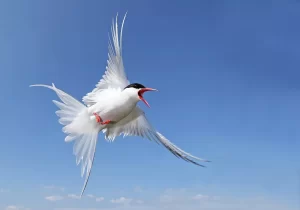What Are Migratory Birds?

Why Do Birds Migrate?
Bird migration is a survival strategy. As seasons change, birds move to areas with more abundant food, better climate, or optimal breeding conditions. Here is a detailed explanation of why birds migrate:
1. Seasonal Changes in Climate
One of the main reasons birds migrate is to escape harsh weather conditions.
- In temperate and polar regions, winters can be very cold with limited food availability.
- Birds move to warmer regions during winter where conditions are more favorable for survival.
- In spring and summer, they return to their breeding grounds where longer daylight hours and abundant food support nesting and raising young.
2. Availability of Food
Migration helps birds follow food sources that change with the seasons.
- Many birds feed on insects, nectar, or fruits, which are not available year-round in colder climates.
- By migrating, birds can access food-rich environments throughout the year.
- For example, swallows eat flying insects that are only abundant in warm climates.
3. Breeding Opportunities
Birds migrate to take advantage of ideal breeding conditions.
- Northern regions often have fewer predators, less competition, and abundant resources in the summer, making them ideal for raising chicks.
- Longer daylight hours in these regions also allow birds to feed their young more frequently.
Popular Migratory Bird Species
Some of the most popular migratory bird species known for their remarkable journeys include:
Arctic Tern: Holds the record for the longest migration, traveling about 90,000 km roundtrip from the Arctic to the Antarctic each year. They can live up to 30 years, covering distances equivalent to going to the moon and back multiple times in a lifetime.
Bar-tailed Godwit: Known for the longest nonstop flight of any bird, flying over 8,400 miles nonstop from Alaska to New Zealand or Australia in about 11 days. Their bodies adapt by changing organ sizes to maximize energy storage for the flight.
Snowy Owl: Migrates south irregularly from northern Canada and the Arctic, sometimes reaching as far as Florida and Texas. Their migration patterns vary year to year and are partly nomadic.
Northern Mockingbird: A resident migratory bird in the mainland U.S., southern Canada, Mexico, and the Caribbean, present year-round in many areas.
Orchard Oriole: Breeds in the eastern U.S. during summer and migrates to Mexico and South America for winter.
Painted Bunting: Found year-round in the U.S., with migration patterns including summer in the Rocky Mountains and Pacific Coast and winter in Florida and Central America.
Sooty Shearwater: Migrates thousands of miles annually across the Atlantic and Pacific Oceans, with Pacific populations traveling up to 40,000 miles per year.
Northern Wheatear: Breeds across Eurasia and northern North America, migrating to sub-Saharan Africa for winter, with some flights exceeding 9,000 miles.
Migration Calendar by Region
North America
- Spring: March – May
- Fall: August – October
Europe
- Spring: April – June
- Fall: September – November
Asia
- Spring: March – May
- Fall: September – November
Migratory Bird Treaty Act of 1918 – Overview
The Migratory Bird Treaty Act of 1918 (MBTA) is a foundational U.S. federal law designed to protect migratory bird species. It implements international treaties between the U.S. and other countries—initially Canada (1916), and later Mexico, Japan, and Russia—to conserve migratory birds that cross international borders. The Act prohibits the “take” of protected migratory birds, which includes hunting, capturing, killing, selling, trading, or transporting these birds or their parts (feathers, eggs, nests) without authorization from the U.S. Fish and Wildlife Service.
The MBTA was enacted in response to severe declines in bird populations caused by overhunting and the demand for feathers in fashion, particularly for women’s hats. Before the MBTA, state laws were insufficient to protect migratory birds, which move across state and national boundaries. The Act established federal authority over migratory bird conservation, a power upheld by the Supreme Court in Missouri v. Holland (1920), which affirmed that treaty obligations can supersede state rights in wildlife regulation.
The law protects over 1,000 species of migratory birds that occur naturally in the U.S., listed in federal regulations (50 CFR 10.13). It forbids any unauthorized pursuit, take, possession, or commerce involving these birds and their parts, with some exceptions for scientific, educational, or Native American religious uses under permit.
The MBTA remains one of the most important bird protection laws in the U.S., helping prevent the extinction or severe decline of many migratory bird species for over a century. It also serves as a model for wildlife conservation and federal environmental regulation.
Popular Migratory Bird Refuges Around the World
1. Point Pelee National Park
- Location: Ontario, Canada
- Habitat: Forest, wetland, and sandy beach
- Key Species: Warblers, thrushes, vireos, flycatchers, hawks
Details:
Point Pelee National Park is one of the top birdwatching destinations in North America, particularly during the spring and autumn migration periods. Situated at the southernmost tip of mainland Canada, the park is an important rest stop for thousands of migratory songbirds crossing Lake Erie. The park’s diverse habitats, including swamps, marshes and Carolinian forest, support over 390 bird species. Designated an Important Bird Area (IBA), it attracts birders from around the world.
2. Bharatpur Bird Sanctuary (Keoladeo Ghana National Park)
- Location: Rajasthan, India
- Habitat: Wetlands, grasslands, woodland
- Key Species: Sarus crane, bar-headed goose, painted stork, Siberian crane (historic)
Details:
Bharatpur Bird Sanctuary, a UNESCO World Heritage Site, is one of the most famous bird sanctuaries in Asia. Originally a royal duck-hunting reserve, it was converted into a protected sanctuary. Over 370 species have been recorded here, including many migratory waterfowl that arrive in winter from Central Asia and Siberia. The shallow wetlands provide ideal conditions for breeding and feeding.
3. George C. Reifel Migratory Bird Sanctuary
- Location: British Columbia, Canada
- Habitat: Coastal wetlands, marshes, and dikes
- Key Species: Snow geese, sandhill cranes, mallards, northern pintails
Details:
Located near Vancouver, this sanctuary covers over 300 hectares and lies along the Pacific Flyway. It is a vital resting and feeding area for thousands of migratory birds. Snow geese arrive in large flocks in fall, and many waterfowl and shorebirds stop here during their long migrations. It is also home to several species year-round and offers excellent opportunities for public birdwatching and education.
4. Doñana National Park
- Location: Andalusia, Spain
- Habitat: Marshes, lagoons, dunes, scrubland
- Key Species: Greater flamingo, glossy ibis, Eurasian spoonbill, marbled teal
Details:
Doñana is one of Europe’s most important wetland reserves and a haven for migratory birds between Europe and Africa. The marshes flood seasonally, attracting hundreds of thousands of birds. More than 300 species have been recorded, and it’s a critical wintering and stopover site. It is recognized as a UNESCO World Heritage Site and Ramsar Wetland of International Importance.
FAQs About Migratory Birds
1. What four birds aren’t in the Migratory Bird Treaty Act?
The Migratory Bird Treaty Act (MBTA) primarily protects native migratory birds. However, it does not protect certain non-native species that are present in the United States solely due to human introduction. Four notable bird families or groups not protected by the MBTA include:
- European Starling (Sturnidae, except as listed in Japanese treaty)
- House Sparrow (Passeridae, specifically Passer domesticus)
- Mute Swan (Cygnus olor)
- Rock Pigeon (Columba livia)
These species are excluded because they are not considered native and their presence is due to intentional or unintentional human introduction.
2. When is World Migratory Bird Day 2025 and what is its theme?
- Dates: May 10, 2025 (spring) and October 11, 2025 (fall)
- Theme: “Shared Spaces: Creating Bird-Friendly Cities and Communities”
World Migratory Bird Day 2025 focuses on the importance of making urban areas safer for migratory birds, highlighting threats such as habitat loss and collisions with buildings. The campaign encourages sustainable city planning and community involvement to support migratory bird populations.
3. Are crows migratory birds?
Crows exhibit partial migration.
In North America, many crows migrate, while others remain in the same area year-round. For example, 86% of eastern crows and 73% of western crows migrate to breed, traveling an average of about 310 miles. Some crows are consistent in their migration habits, while others are resident and do not migrate.
4. Are robins migratory birds?
Yes, but with variation.
American robins are known for their migration, especially in northern regions. However, many robins in the continental U.S. remain in the same area all year. Robins from Canada and the northern U.S. migrate south for the winter, while others stay put if conditions allow.
5. Are doves migratory birds?
Many doves, especially Mourning Doves, migrate.
Mourning Doves breed across North America and migrate south to the U.S. Gulf Coast, Mexico, and Central America for winter. Some doves in more southern regions may stay year-round or only move short distances, but northern populations are strongly migratory.
6. Are blue jays migratory birds?
Blue jays are irregular (partial) migrants.
Some blue jays migrate south in large flocks, while others remain in their northern breeding territories throughout winter. The decision to migrate can vary from year to year for each bird, and young jays are more likely to migrate than adults.
7. Are cardinals migratory birds?
Northern Cardinals are generally non-migratory.
They are considered permanent residents and stay in the same area year-round. While rare long-distance movements have been recorded, cardinals do not typically migrate like many other songbirds. Their varied diet and adaptability help them survive winter conditions

 Facebook
Facebook  Instagram
Instagram  Youtube
Youtube 